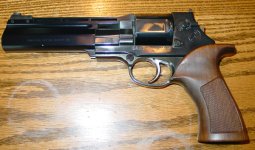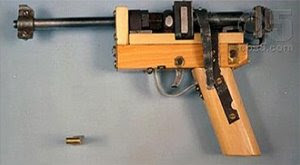Was at cabelas and saw a 329 pd.....a .44 at 20-somethin ounces? I find it to be rediculous. Then theres the magnum snubnosed airweights, which kick with 357 force on a gun you can't even fit your whole hand on the grip. Whats next, an airweight 500 mag? Anyone else see a pistol that they thought was a bad idea?
You are using an out of date browser. It may not display this or other websites correctly.
You should upgrade or use an alternative browser.
You should upgrade or use an alternative browser.
Pistols you think are just a bad idea....
- Thread starter SPUSCG
- Start date
mikejonestkd
New member
The judge....
kayakersteve
New member
Well, this comes to mind....


I myself have 3 revolvers I think are a bit silly. They are the BFR and Ruger SRH in 454 along with a 44 mag SBH hunter. They all carry a scope, which enables me to hit (at least with these guns out to 200 yards fairly easily). They are all too big to carry. I have and do hunt with handguns and have made kills with more carryable alternatives. Scope on handguns just doesn't fit for me. They are supposed to be easy to stow and get around with.
zombieslayer
New member
Some of the BIG s&w's are ridiculous. But my beloved pistol gripped 590 is a joke to most people.
oneounceload
Moderator
Side by side shotguns ( I know it's the wrong forum, sorry), with tacticool rails on it and a black-painted stock.....:barf:
otherwise, make it those nice cheap chinese/phillipine/brazilian semis
otherwise, make it those nice cheap chinese/phillipine/brazilian semis
SigP6Carry
New member
http://world.guns.ru/handguns/hg212-e.htm
just think about how many pieces can go completely awry between the magazine and chamber alone!
just think about how many pieces can go completely awry between the magazine and chamber alone!
oneounceload
Moderator
to me, the Boberg looks like a good gun
SigP6Carry
New member
I don't know, I just don't trust an arm that grabs the bullet in the magazine below the chamber, then pulls the bullet back, levels it with the chamber and then proceeds to inject it before dropping down to grab the next round... too much to go bad.
And if something does go wrong, it's less likely to be easy fix.
As far as guns that I think are poorly thought out (not including unforeseen flaws that became apparent after the designing process is already over), I can think of 2. I own one, and used to own the other.
First, the H&R 622 revolver. Sure, it's accurate and all, but in an apparent cost-cutting measure, they designed it so that when you wanna load/unload (instead of being a top-break, or swing-out cylinder, or even a gate-loader) you have to remove the cylinder entirely from the frame to eject spent casings and reload and then reinstall the cylinder. It's a slow, cumbersome, and dirty process that makes even gate-loaders seem convenient and practical.
The second would be the striker-fired Sterling .22 pocket pistol. This is a gun that does not have a slide lock function. When you fire the last round, it cocks the gun and the slide goes into battery as if there was a round chambered. If you don't keep count of how many shots you've fired, you'll end up dry-firing the gun. Yet the gun is NOT dry-fire safe. Furthermore, the gun was not designed with any actual means to de-cock it.
As far as guns that I think are poorly thought out (not including unforeseen flaws that became apparent after the designing process is already over), I can think of 2. I own one, and used to own the other.
First, the H&R 622 revolver. Sure, it's accurate and all, but in an apparent cost-cutting measure, they designed it so that when you wanna load/unload (instead of being a top-break, or swing-out cylinder, or even a gate-loader) you have to remove the cylinder entirely from the frame to eject spent casings and reload and then reinstall the cylinder. It's a slow, cumbersome, and dirty process that makes even gate-loaders seem convenient and practical.
The second would be the striker-fired Sterling .22 pocket pistol. This is a gun that does not have a slide lock function. When you fire the last round, it cocks the gun and the slide goes into battery as if there was a round chambered. If you don't keep count of how many shots you've fired, you'll end up dry-firing the gun. Yet the gun is NOT dry-fire safe. Furthermore, the gun was not designed with any actual means to de-cock it.
thebantas@VERIZON.NE
New member
game over. I win. 


SigP6Carry
New member
The P7 is actually a pretty neat idea. It's not hard to cock it, it's like a Colt grip safety, only more positive.


